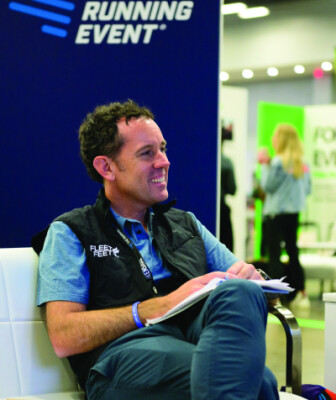It’s 2022 marathon weekend in New York City and the Fleet Feet Columbus Circle store located on the southern edge of Manhattan’s Central Park is hopping. A line of customers extends 10 deep at checkout. In two days, the store will record more sales than many U.S. running stores capture in a month.
Amid this controlled madness, a young female customer approaches the cash wrap. She looks at the fit, fortysomething-ish man behind the counter with brown curly hair and a decidedly un-New York City tone to his voice.
“Are you the CEO?” she asks.
“Yes, I am,” the man responds.
After a quick exchange, the woman – Molly McQueeny, the digital marketing manager at Fleet Feet Chicago in town for the NYC Marathon – requests a photo. Joey Pointer happily obliges, leaning over the cash wrap to squeeze his smile into the frame.
For two days, Pointer worked the register at the Columbus Circle store, spending some 15 hours checking out customers, interacting with staff and dealing with quirky inefficiencies the CEO of the nation’s largest running store chain wouldn’t have discovered if not for this adventure on his retail operation’s frontlines.
“It was an eye-opening experience,” Pointer recalls during a conversation with Running Insight editorial staff at The Running Event on November 30. “Just from those two days there, I created a list of 10 different things I thought we could improve.”
For Pointer, excellence is always under construction – even at a fast-charging brand with $500 million in systemwide sales.
The Year That Was
It’s been a wild year for Pointer, a man who joined the Fleet Feet enterprise 18 years ago when the upstart company used AOL email addresses and was a big fish in the run specialty pond, not the rhino it is today with nearly 300 stores and 2000 employees.
Recall that just prior to The Running Event in 2021, news broke that Fleet Feet was acquiring the nation’s second-largest running store chain, JackRabbit, and its dozens of locations across 15 states. For Pointer and his leadership team, the headline-grabbing deal ignited a long to-do list.
As such, much of the last year has revolved around integrating JackRabbit stores into the Fleet Feet enterprise and solving market conflicts in metro areas such as Cincinnati, where existing Fleet Feet franchisees Frank and Stacey DeJulius agreed to purchase four JackRabbit stores – shops originally a part of Bob Roncker’s run specialty empire – from Fleet Feet corporate.
In transitioning JackRabbit stores to Fleet Feet operations, Pointer and his leadership team embraced an inside-out approach. It began with immediately converting JackRabbit’s tech stack, from point-of-sale systems to gift cards, before flipping the employee and customer experience, which included introducing the brand’s fit id 3D-foot scanning experience to JackRabbit showrooms.
Now, Pointer says, Fleet Feet is working to connect the final pieces, such as installing Fleet Feet signage on the exterior of all locations. By the end of 2023’s first quarter, Pointer hopes the puzzle is complete.
“Of course, we wanted to snap our fingers and have it happen faster, but something like this takes time,” Pointer reminds.
Which isn’t to suggest it was all JackRabbit all the time in 2022. In fact, Pointer closed another significant deal last June with the purchase of New England-based Marathon Sports and its soundRUNNER and Runner’s Alley brands from Colin and Penny Peddie. The 18-store acquisition pushed Fleet Feet closer to 300 U.S. running stores. (Unlike JackRabbit, however, Marathon Sports continues operating as a separate entity under the Marathon Sports, soundRUNNER and Runner’s Alley names with its own Waltham, MA-based leadership team.)
“We didn’t buy JackRabbit to check something off the list,” Pointer says. “We kept our eyes on what’s next.”
Fleet Feet Marches On
Ask Pointer for one word to describe his last year at the helm of Fleet Feet and he pauses. Thoughtful and methodical, his mind circles for a single term to describe a year that brought its share of challenges and triumphs. He looks up.
“Humbling,” he says. “A lot of people are counting on the decisions I make. Even if I don’t make decisions in isolation, that responsibility hits me every day.”
A self-professed lover of growth, Pointer says he wants to fast forward five years from now to assess Fleet Feet’s fortunes. Did the decisions he make pan out? How are operating partners doing? Were acquiring JackRabbit and Marathon Sports the right moves?
But Pointer understands life doesn’t have a fast forward button. He must exist in the present, even if today’s decisions – the people he promotes, the stores he selects for renovations, the systems he chooses – impact tomorrow’s results.
At present, about 40 percent of Fleet Feet stores are company-owned operations with the remaining owned by franchisees. Pointer favors that ratio and aims to grow on the franchised side with a mixture of existing owners and new partners, particularly in untapped markets. He also continues to actively consider acquisitions.
“We know we’re going to open more stores,” he says. “We’re in a sailboat and we’ll see where it goes.”
But growth, Pointer notes, does not have to come solely from opening new stores. It can also come from heightening brand awareness, which he admits lags in some markets.
Alongside goals to build a portfolio of 400 stores and reach $1 billion in systemwide sales – the latter being an if-not-when proposition for Pointer – the Fleet Feet CEO wants to increase brand awareness 75 percent over the coming years. His ultimate goal: to build a 100-year-old brand, a target still more than a half-century away.
“Our success is based on being a community retailer,” he says. “So long as we hold this near and dear, our best days are yet to come.”







